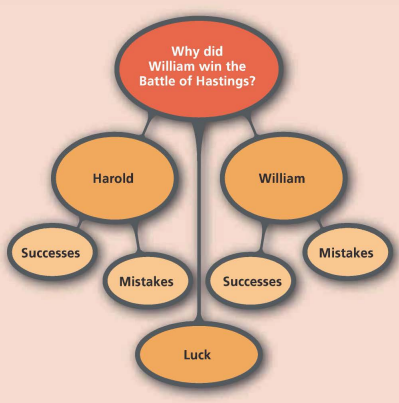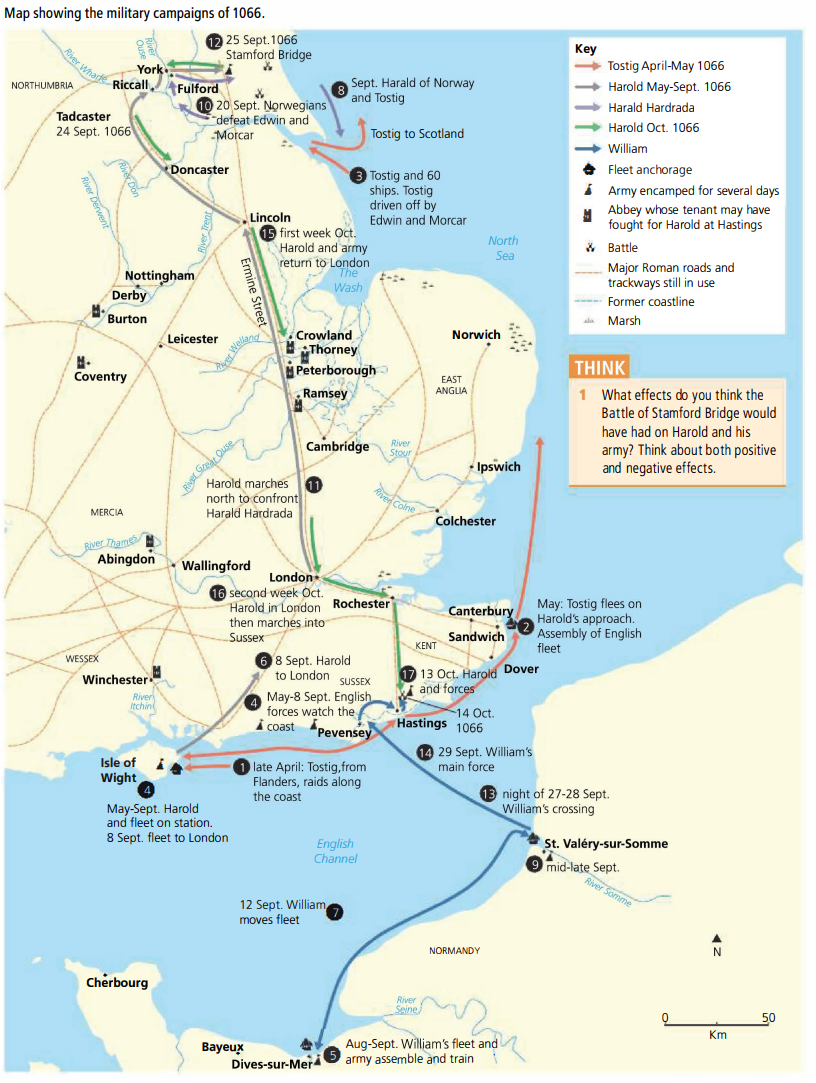Why did William win the Battle of Hastings?

Harold knew he would have to defend his throne and from the start of his reign he started preparing.
- Harold expected an invasion from Normandy so assembled a navy, but he didn’t have any boats so he demanded boats from seamen around the country who complied.
- He also assembled an army, however even in those days the King wouldn’t keep a standing army, when he would need to fight, he would call upon the housecarls, thegns and fyrd (professional soldiers, lords and ordinary people).
Harold had all his troops stationed on the south coast of England waiting for William - however it was not William who came but Harold’s brother Tostig.
The Tostig interlude
- Tostig had been removed from his position as Earl of Northumbria in 1065 and was sent to exile in Flanders. However he convinced Harald Hardrada that he should come back to England and seize the crown from Harold.
- In may 1066 Tostig started his campaign, his ships and soldiers raid towns along the Sussex coast
- Tostig occupied the town of Sandwich for a while but the threat of Harold’s army scared him off.
- Tostig went north then some raids in Lincolnshire before Earls Edwin and Morcar made him flee to Scotland where he waited for Hardrada.
May to September - William’s preparations
- William’s preparations were slower but mostly because they were more thorough.
- Some Normans thought it was an risky enterprise - which it was but William was confident and persuaded others it could be successful.
- He even got the support of the Pope who gave him a Papal Banner to carry into battle it meant that God was on their side.
- William had no army, instead he had to call on his lords to bring themselves and their knights from Normandy and beyond.
- He also didn’t have a navy, so he had to ask his vassals to provide some ships - they couldn't’ provide enough so he ordered hundreds of ships to be built.
- To secure his position once he was in England, William pre-fabricated castles to take to England (like IKEA furniture so all you have to do is assemble it and not measure wood etc).
- While Harold was waiting for three months on the Sussex coast, William’s invasion force was gradually being assembled then trained.
- By August, William had 7,000 soldiers (including cavalry and archers) with up to 3,000 horses and around 700 ships, all training and preparing to invade England.
September 8th - Harold’s army goes home
- Harold had a problem - you cannot keep an army of 6,000 men together forever.
- The 3 month wait had exhausted resources, the soldiers needed paying and feeding, along with this, many of the soldiers were ordinary men who needed to get back to their villages to bring in the harvest.
- On September 8th, Harold sent his soldiers home and he went to London.
- This was poor timing as a few days later William moved his entire fleet to Saint Valery to await favourable wind to cross the channel.
- At the same time Tostig and Harald Hardrada were sailing down the north east coast from Scotland with a fleet of 300 ships and up to 8000 soldiers to prepare to invade the north of England.
Early September- The return of the Vikings
- Hardrada joined Tostig at the River Tyne and they landed at Riccall, near York.
- Hardrada’s claim to the throne was weak but he was a fierce warrior.
- On the 20th of September, During the Battle of Fulford, Earls Edwin and Morcar were defeated, but not killed - York surrendered to Hardrada.
Mid-September- Harold marches north
- When Harold learned of Hardrada’s arrival he re-gathered his army and marched north - his men covered nearly 200 miles in under a week.
- They were so quick that they caught Hardrada and Tostig by surprise at Stamford Bridge on the 25th of September - the fighting was fierce and lasted most of the day.
- Harold’s men won and Hardrada, Tostig and most of the Norwegian army died.
- Harold’s victory was short lived as within three days he received news that William had landed in England.

The Norman landing
- Bad weather had delayed William’s invasion plans but the weather cleared and he set sail around the 27th of September landing at Pevensey the following morning whilst Harold’s army was still in the north.
- Pevensey was a good choice because the Roman fort offered some protection and it was a safe bat to land his army and supplies. The Normans quickly built their first castle and began terrorising the local population.
Harold’s reaction
- As soon as Harold heard of William’s invasion he travelled to London and his mounted soldiers with him - they covered 200 miles in 4-5 days. He likely gathered a new army of foot soldiers in London
- Harold wanted to fight close to London however William wanted to fight near Pevensey.
- If Harold could not tempt William north then he would surprise William the same way he surprised Hardrada. This victory likely made Harold over confident.
The Battle of Hastings - 14 October 1066
Harold neared Hastings on the 13th of October but knew there was no chance of surprising William. William expected an attack during the night however Harold paused and camped overnight near Senlac Hill due to his army’s exhaust. In the early morning of October 14th, William went to find Harold’s army and when he found them at Senlac Hill the two sides prepared for battle.
Formations
- Both sides were evenly matched numerically with both having around 7-7,000 troops. But there were some key differences in how they were armed and positioned.
- The English seized the hill top and the housecarls formed their customary shield wall. Behind it were the fyrd who carried simple weapons like iron-studded clubs. The fyrd were led by the thegns armed with swords and javelins - Harold had no archers and only used horses to transport troops and equipment.
- By contrast William had heavily armed cavalry who fought in units of 5 to 10. The speed and power of horses charging could be devastating to foot soldiers.
- Williams first line of foot soldiers included archers and the second line were foot soldiers armed with swords and shields and cavalry.
The start of the battle
- First, Norman arrows rained down on the English troops but the shield wall remained firm - the Normans had to advance in order to engage in hand-to-hand fighting.
- The second row advanced to the English front line, shields meeting shields - the English resisted and their hill-top position gave them an advantage.
- The Norman cavalry could not charge up the steep and uneven ground so the Norman cavalry had to fight at close-quarters, hurling javelins at the English or hacking with swords - the English battle-axes were effective in the kind of fighting.
- The two sides were well matched and the battle continued throughout the day.
The turning point
( There is no single reliable account of what happened next - the sources disagree)
- According to William of Poitiers, a rumour arose that William had been killed and the ferocity of the English led the Norman soldiers on the left flank to flee - Harold could’ve seized the advantage at this point but failed.
- Apparently William acted swiftly - according to Orderic Vitalis he shouted to his men:
'Look at me! I am alive, and with God's help I will conquer! What madness is persuading you to flee? What way is open to escape?' No sooner had the Duke spoken these brave words than their failing courage was restored.'
- Other sources say the Normans deliberately retreated to tempt the English to break rank so they could then turn and attack - this is a Norman tactic called ‘feigned retreat’.
- Regardless, the English shield began to crumble but Harold tried, unsuccessfully to prevent his troops from following the Norman retreat but their lack of experience was exposed.
- Harold was killed somewhere in the chaos of the battle.
- Once Harold was dead the battle was over.
Conclusions
- William defeated Harold because he had better tactics and was a more effective commander of his troops.
- The English defensive formation worked well for a long time but during the battle William took great personal risks and if he had died the Normans likely would have lost the battle.
- With Harold dead and the English defeated William had overcome the first major obstacle in his attempt to conquer England.